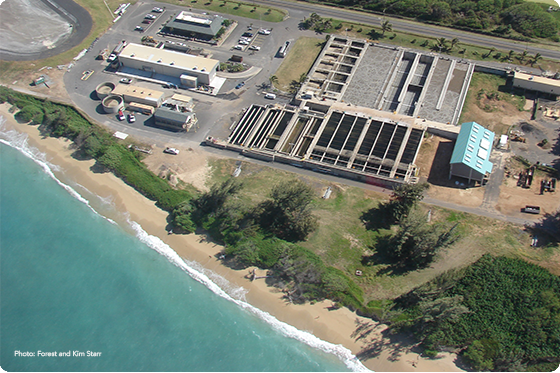
In a 6-3 opinion by Justice Stephen Breyer, the U.S. Supreme Court held that the federal Clean Water Act (CWA) requires the federal government to regulate some groundwater pollutants that discharge into navigable waters. (Cty. of Maui, Hawaii v. Hawaii Wildlife Fund, No. 18-260, 2020 WL 1941966 (U.S. Apr. 23, 2020)). The CWA prohibits the addition of any pollutant from a point source to navigable waters without the appropriate permit. In this case, the Supreme Court had to determine whether a permit is necessary “when pollutants originate from a point source but are conveyed to navigable waters by a nonpoint source, here, ‘groundwater.’”
The pollutants at issue in this case come from a wastewater treatment plant operated by Maui County, Hawaii. Approximately 3 to 5 million gallons of treated wastewater per day are injected by the County into the groundwater via underground injection control (UIC) wells. Pollutants from the wastewater injections travel about half a mile and are discharged into the Pacific Ocean.
Environmental groups filed suit over the plant’s activities, claiming that Maui County violated the CWA by discharging the pollutants without a CWA permit. The County argued that discharges are regulated by the CWA only when pollutants are directly discharged into navigable waters. The federal district court ruled in favor of the environmental groups, and the Ninth Circuit affirmed. (Hawai’i Wildlife Fund. v. County of Maui, 881 F.3d 754 (9th Cir. 2018)). The appellate court held that when the pollutants are “fairly traceable” to the point source and are more than minimal amounts, the CWA applies.
Other federal circuit courts have previously ruled on the issue. The Fourth Circuit court reached the same conclusion as the Ninth Circuit but used a different test for determining when the CWA applies to groundwater discharges, holding that the CWA only covers groundwater when there is a “direct hydrological connection” between the groundwater and the navigable waters. (Upstate Forever v. Kinder Morgan Energy Partners, L.P., 887 F.3d 637 (4th Cir. 2018)). In contrast, the Sixth Circuit held that groundwater was not a point source under the CWA, and groundwater pollution could not give rise to CWA liability under a “hydrological connection” theory. (Kentucky Waterways All. v. Kentucky Utilities Co., 905 F.3d 925 (6th Cir. 2018)). The Supreme Court granted certiorari to resolve the split and provide clarity on the scope of the CWA.
Following the Supreme Court’s grant of cert in Hawaii Wildlife Fund, the U.S. Environmental Protection Agency (EPA) issued an Interpretive Statement on the application of the CWA to groundwater. The EPA concluded that the discharge of pollutants to groundwater is excluded from the Act’s permitting requirements, regardless of a hydrological connection between groundwater and navigable water.
The Supreme Court overturned the Ninth Circuit’s ruling. The Court rejected the “fairly traceable” test, but it also rejected the argument to exclude groundwater from CWA permitting requirements entirely. The court found the former argument too broad, and the latter too narrow. Instead, the Supreme Court found that the groundwater discharges would fall under the CWA permitting requirements based on a “functional equivalent” standard. The Court stated, “[w]e consequently understand the permitting requirement, §301, as applicable to a discharge (from a point source) of pollutants that reach navigable waters after traveling through groundwater if that discharge is the functional equivalent of a direct discharge from the point source into navigable waters.” Essentially, an “addition” will be regulated under the CWA when directly deposited from a point source or “when the discharge reaches the same result through roughly similar means.”
The Court stated that many factors would be necessary to decide if the functional equivalent standard is met, noting that time and distance would be the most important. Other relevant factors include: the nature of the material through which the pollutant travels; the extent to which the pollutant is diluted or chemically changed as it travels; the amount of pollutant entering the navigable waters relative to the amount of the pollutant that leaves the point source; the manner by or area in which the pollutant enters the navigable waters; and the degree to which the pollution (at that point) has maintained its specific identity. The Court pointed out that other courts would provide additional guidance through forthcoming rulings. Further, the EPA may provide administrative guidance on when the standard is met.
Justice Clarence Thomas and Justice Samuel Alito wrote separate dissents. Justice Thomas’ dissent, which was joined by Justice Gorsuch, asserted that a permit should only be required when a point source discharges pollutants directly into navigable waters. Justice Alito’s opinion alleged that the Court’s functional equivalent test did not provide the necessary guidance and could therefore result in arbitrary and inconsistent application. Nevertheless, the Court’s majority remanded the case to the Ninth Circuit for further proceedings consistent with the newly declared “functional equivalent” standard.












